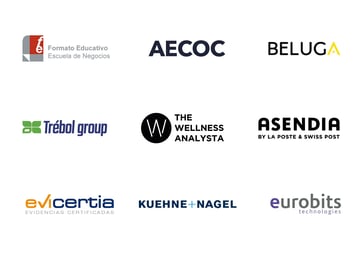Supercharge Your E-Commerce with Shopify HubSpot Integration.
Your Shopify Store’s Secret to Marketing Success.

We are a HubSpot Partner Agency and we are certified in:
 Inbound Marketing
Inbound Marketing Performs marketing actions and integration of the entire system under one tool.
 Inbound Sales
Inbound Sales Increase the productivity of your sales team.
CHOOSE YOUR SECTOR
 Sectores
Sectores Choose a sector to learn how we prepare sales and marketing strategies according to your specifications and objectives.
 Hayas Clients
Hayas Clients Read the testimonials of our clients and their results after choosing us for different Marketing and Sales actions. 

5 min read
![]() Hayas Team
:
Jan 3, 2022 1:40:03 PM
Hayas Team
:
Jan 3, 2022 1:40:03 PM
A Global Marketing Strategy allows you to have a website and content adapted to each country or region that shares the same language and a unique Marketing Strategy, but adapted to each market, country or region.
Globalization is an economic, political and social reality based on communication and interaction between countries and offers companies invaluable business opportunities. Digital technology and modern means of transportation have minimized if not completely eliminated geographical impediments, but the language barrier is still evident, causing more than one headache for companies in the process of expansion, those who want to offer their services to international customers or those who simply want to export their products abroad.
For marketing, language marks the real scope of an intervention and determining which one(s) to work on is therefore essential in order to design a strategic plan accordingly. If the ultimate goal is to bring a product or service closer to a customer to meet a need, we have to make sure that the message arrives in the right code and through the right channels. This implies generating content in as many languages as markets we want to access and we will always approach translation based on a market study and in accordance with the rest of the globalization processes.
The terms internationalization and localization originate in the field of computer engineering, but their enormous strategic relevance makes them applicable to all types of business and commercial processes. They are two complementary and consistent lines of action: we can say that internationalization is a global plan that precedes and facilitates the effective execution and integration of the different localization projects. Below we will see in more detail what they consist of and what objectives they pursue.
If we consider that our product or service is objectively exportable, we will consider translating it to maximize its impact among speakers in the markets of interest. It then becomes a product or service with multiple versions, and digital and physical media must be able to accommodate all of them and alternate them, which may entail configuration or design tweaks.
If we translate a product or service into one or more languages for the convenience of our customer, we cannot neglect the associated content, because providing access to, for example, instruction manuals, technical support, or promotions will maximize their user experience. Likewise, except in rare exceptions justified by the particularities of either the product or the market, we do not usually translate the associated content into a language in which your product or service is not available.
Fortunately, it is becoming increasingly common to use at least two languages in the professional environment, and there is a very good chance that one of them will be English. To lay the groundwork for the globalization plan, it is common to use English as the lingua franca in our interactions, and we also see this practice as part of i18n's strategy.
In order to determine into which languages we want to translate, we must know who the Buyer Persona will be (the profile of the person who will purchase our product or service). We must take into account the different linguistic realities of the market to which they belong.
At a technical level in content marketing we need to adapt the different local contents to search engines with SEO techniques. Using the right technology and tools helps us to replicate correctly and easily the SEO onpage configuration or SEO techniques that are performed to optimize the website. Some of the most popular tools for content localization are the WPML plugin for Wordpress, the HubSpot CMS (which offers native creation of multi-language web pages) or tools such as Weglot, which integrate with the main content management systems or CMS.
Regardless of the languages into which we translate our product or service, we will have to decide whether we can communicate directly with the customer in their language or whether we will use English as the lingua franca. In any case, we will pay attention to extra-linguistic issues such as time zones, courtesy formulas, or currency, and we will adapt to the system that offers greater clarity to avoid misunderstandings.
Localization or regionalization, also known as l10n, is the process of adapting a product or service to the local taste of a specific region. Translation is its main tool, but it also considers and deals with issues beyond the strictly linguistic; to localize is also to adapt to a specific culture and society, as well as to the particularities of its market.
Regarding the localization of content on websites, an investigation of CSA Research based on large representative samples from 29 countries around the world, revealed that 65% of customers prefer content in their native language. And 40% of consumers will not buy from a website or ecommerce site in a language other than their own.
With translation, you adapt a message. With localization, you adapt an experience. Although translation and localization are two different processes, message adaptation is often part of digital experience adaptation.
Below we will look at the main challenges of localization and some solutions based on specialization.
Determining the number of speakers of a language at a global level is for example vital to understand the real scope of a localization strategy and will provide us with concrete figures of potential customers, but it must also be contrasted with other indicators such as internet access, purchasing power or level of education.
Once the preferred market has been selected and the localization strategy has been designed, we have to approach the task of translating the content in a systematic and efficient manner. The volume and format of the content will determine the size of the translation project, the resources it will consume, its economic viability and its scheduling. A project of a few thousand words in a document (one-off translation) does not require the same upfront work as the translation of multimedia content that is updated periodically (recurring translation), to cite a specific example.
The idiosyncrasies of our preferred market may require actions beyond translation. Just as we cannot assume that all pre-existing content is automatically relevant to the new market, we need to identify and meet their unique needs, and this may mean generating customized content especially for them.
Approach the study of a specific market by paying special attention to the language used by our end users. For the complete localization of a product or service, apart from a good marketing analysis, we always recommend working with translators located in the preferred market, as they have a privileged, insider's perspective that will be very useful.
Not all companies can take on the tasks involved in the localization of their product or service, but fortunately there is a wide range of agencies and freelancers that can handle the translation. Do not hesitate to request quotes from different external providers, but keep in mind that their professionalism, work pace and methodology will have as much or more impact as their rates on the success of the project.
In translation theory there are two lines of thought: the one that considers the equivalence between source and target texts, and the one that prefers to approach it in a less formal way. Transcreation is a translation technique that belongs to this second group and is very widespread among marketing and advertising professionals, as it is a process that seeks to transcend the limits of culture and language, to subtract a message from the source language and transfer it while maintaining its intention, style, tone and context so that it evokes the same emotions and has similar and equivalent implications in the target language..
When designing it, a global marketing strategy must know how to apply what has already been proven to work (general, inclusive perspective), but without losing sight of the tastes and needs of the new market (focused, exclusive perspective). Being able to see the confluences of these two approaches is crucial to be able to develop a plan that brings a product or service closer to its natural user, without its belonging to a certain group of speakers being an impediment.
Developing a Global Marketing Strategy covers the same phases as one that is exclusively local in scope, but proper content management becomes even more relevant when it comes to multilingual content, as the whole process has to be framed and at the same time based on the globalization plan itself.
By combining internationalization and localization strategies, we achieve a comprehensive approach that will show us the path to follow progressively and based on results obtained in each region or market.

Your Shopify Store’s Secret to Marketing Success.

If you're ready to enhance your sales efforts, it's time to delve into the world of HubSpot Sales Hub. This potent tool equips you to manage your CRM...
